After years of spiraling real estate prices, fears of long protracted war prodded thousands of New York Jews to withdraw money from their local banks during the summer of 1914. For years these "banks" had not only kept immigrant Jews' small deposits, but also helped them buy ship tickets for their loved ones in Europe and transfer money back there. Unable to return depositors' funds, New York State's Bank Superintendent forced one of the largest banks on New York's Lower East side, Sender Jarmulowsky's bank, founded in 1873 and claiming over 60,000 depositors, to shutter its doors. On August 30, 1914, the largest financially-driven riot in New York City history to date broke out in front of Jarmulovsky's bank. Demanding the bank return their deposits, the enraged crowd of East European Jews paraded to City Hall where they attacked clerks, forcing police to arrest nine and use clubs to quell rest. The riot frightened city officials, who assigned the city's revered judge, Learned Hand, to settle the claims. Hand soon uncovered that the bank's assets were all tied up in real estate speculation in East Harlem. The incident provoked a myriad of court cases, Hand to write precedent-setting judicial decisions and city officials to craft new banking legislation to protect New York from becoming infected with "speculitis," a disease all agreed was transforming not only New York but America itself.
While few today recognize the name Jarmulowsky or can identify this family's bank - nicknamed "the Temple of Capitalism," the building still stands on the corner of Canal street and East Broadway. This bank and its failure highlight a fascinating aspect of the American economy in the early-twentieth century: while East European Jews occupied marginal (and often disreputable) niches in the businesses of shipping and banking and invited suspicion from large portions of society, they nonetheless were able to move into the mainstream sectors of the economy in a comparatively brief time span by acquiring substantial capital through their risky ventures.
